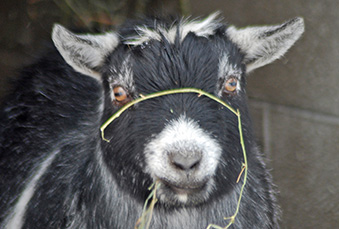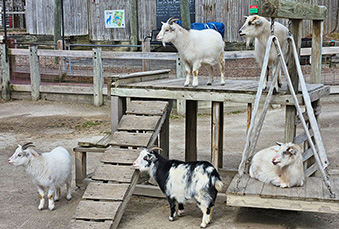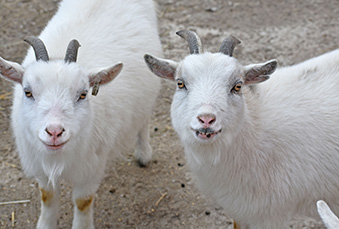Capra hircus | Pygmy Goat
Names:
- Male: Benji, Flash
- Female: Babs, Belle, Blanch, Flopsy



Meet the Pygmy Goats
Small in size but big on charm, our Pygmy goats are the stars of the Contact Yard! These playful and personable animals are a favorite for guests of all ages. Whether they’re hopping on rocks, nudging for scratches, or just showing off their adorable beards, our goats are sure to win your heart with their lively personalities.
From West Africa to Your Backyard
Once known as the “Cameroon Dwarf Goat,” Pygmy goats originated in the Cameroon region of West Africa. Their journey to global popularity began when they were exported to zoos in Germany and Sweden for exhibition. In 1959, a shipment from Sweden brought them to the United States—some going to the Catskill Game Farm in New York, and others to the Rhue family in California.
Today, Pygmy goats are beloved across the U.S. as companion animals, farm residents, and even backyard friends (where permitted).
Pet, Producer, and Performer
Though they’re often kept for companionship, Pygmy goats can also serve as productive farm animals:
- Raised for meat or milk
- Milk has a high butterfat content, ideal for making cheese.
- Not heavy milk producers, but what they produce is rich and creamy.
Their affectionate and friendly nature makes them popular for petting zoos, family farms, and educational programs alike.
Breed Basics
According to the National Pygmy Goat Association, this breed is known for its sturdy, compact frame and endearing personality:
- Small and muscular, with short legs and head.
- Broad body circumference compared to height and weight.
- Coat can be any color or pattern, with medium-length hair.
- Males often have longer, fuller beards.
- Both sexes can have horns.
- Naturally animated, agile, hardy, and good-natured.
You’ll often see them jumping, playing, or relaxing in the sun—true masters of goat yoga!
Thinking of Bringing One Home?
Pygmy goats may be pint-sized, but they still count as livestock—which means there are a few things to know before adopting one:
- Check local zoning laws before bringing a goat home.
- They require space, enrichment, proper diet, and veterinary care.
- Social animals—goats do best with other goat companions.
- Clean, secure fencing is essential to keep them safe and happy.
Being a responsible pet owner starts with research. Understanding an animal’s needs helps ensure the well-being of your new companion—and keeps your community safe and supportive.
Pygmy goats remind us that great things come in small, furry packages. Their intelligence, curiosity, and social nature make them unforgettable animal ambassadors—and wonderful examples of the joy that animals bring to our lives.
Want to make a difference? Support responsible farming practices, learn about animal welfare regulations in your area, and always do your homework before adopting any pet!
Fact Sheet
Taxonomy
Genus: Capra | Species: hircus |
Kingdom: Animalia | Phylum: Chordata | Class: Mammalia | Order: Artiodactyla | Family: Bovidae |
Favorite Enrichment Type
Puzzel feeders filled with grain or bamboo!
Life Span
- In the Wild: (Domesticated)
- In Human Care: 10 to 15 years
Diet
- At the Zoo: Mazuri® goat chow, hay, and grain
Geographic Range
Originating from West Africa, now can be found all over the world.
Habitat
Domesticated grasslands and forests to mountains and agricultural areas.
Goat-ally Fun Facts
- Descendants of the West African Cameroon goat.
- Imported to the U.S. in 1959.
- Can live 10–15 years with proper care.
- Known for their affectionate and engaging personalities.
- Excellent climbers and jumpers despite their short stature.
- Require regular hoof trimming and parasite management.
Status: Not Evaluated (Domesticated)
International Union for Conservation of Nature (IUCN) – Not Evaluated.
How to Find Us
You can meet our Pygmy goats up close and personal in our Contact Yard, located near the playground at the back of the Zoo. Head on over to give them a scratch or brush them! They love visitors!
